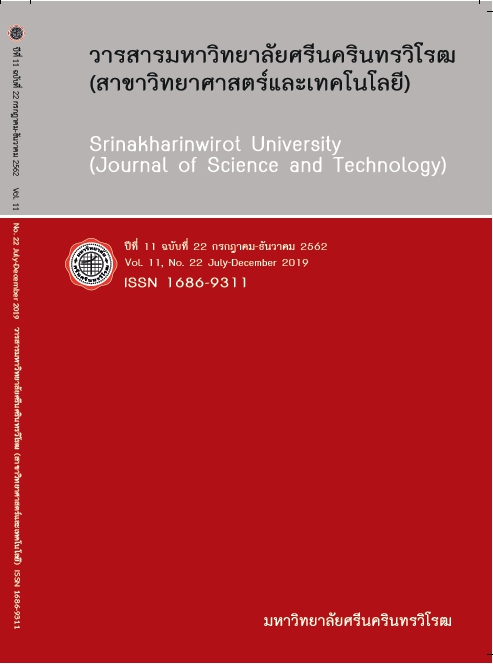ผลการปรับสภาพบรรยากาศต่อคุณภาพและอายุการเก็บรักษาถั่วแขก (PHASEOLUS VULGARIS L.) (EFFECT OF MODIFIED ATMOSPHERE ON THE QUALITY AND SHELF LIFE OF GREEN BEANS (PHASEOLUS VULGARIS L.))
คำสำคัญ:
ถั่วแขก, ปรับสภาพบรรยากาศ, คุณภาพ, อายุการเก็บรักษา, ออกซิเจน, คาร์บอนไดออกไซด์บทคัดย่อ
ถั่วแขก (Phaseolus vulgaris L.) หลังการเก็บเกี่ยวเสื่อมคุณภาพจากการสูญเสียสีเขียว เกิดสีน้ำตาล เสียน้ำหนักและนิ่มลงของเนื้อสัมผัส งานวิจัยนี้มีวัตถุประสงค์เพื่อศึกษาผลของการปรับสภาพบรรยากาศ (ลดออกซิเจน (O2) ร่วมกับเพิ่มคาร์บอนไดออกไซด์ (CO2)) ต่อคุณภาพถั่วแขกเก็บที่อุณหภูมิ 8 °ซ สภาวะการศึกษาคือ O2 ต่ำ (2, 5%) ร่วมกับ CO2 สูง (4, 7, 10%) และสภาวะ O2 ปกติ (21%) + 10% CO2 และสภาวะ 2% O2 + CO2 ปกติ (0.03%) โดยพบว่าถั่วแขกที่ 8 °ซ ในอากาศปกติมีอัตราการหายใจ 82.44 mgCO2 kg-1 h-1 ขณะที่ตัวอย่างในสภาวะปรับบรรยากาศมีค่าลดลงอยู่ในช่วง 5.52 - 66.70 mgCO2 kg-1 h-1 โดยไม่เกิดการหายใจแบบไร้ออกซิเจน ซึ่งมีอัตราการเกิดเอทานอลอยู่ในระดับต่ำมาก 5.52-85.37 µL L-1 ทั้งนี้ผลการเพิ่มความเข้มข้น CO2 เมื่อมี O2 ในระดับเดียวกันทำให้ค่าสีฮิว (hue) ลดลง (90.83-108.27) ดัชนีสีน้ำตาลเพิ่มขึ้น (52.39-85.33) แต่ผลการลด O2 เมื่อมี CO2 ในระดับเดียวกันช่วยคงค่าสีเขียวและลดค่าดัชนีสีน้ำตาล การใช้ O2 ที่ 2% ร่วมกับ CO2 ปกติ (0.03%) ทำให้ตัวอย่างมีสีเขียวมากกว่า ค่าความเป็นกรดเบสคงที่ และมีค่าของแข็งที่ละลายน้ำมากกว่าตัวอย่างในสภาวะบรรยากาศอื่น เมื่อเพิ่มความเข้มข้น CO2 พบว่าการสูญเสียน้ำหนักมีค่าเพิ่มขึ้นในช่วง 4.99 - 7.25% ทั้งนี้ในทุกตัวอย่างมีค่าความเหนียวของเนื้อสัมผัสไม่แตกต่างกัน ดังนั้นการใช้ O2 ที่ 2% ร่วมกับ CO2 ปกติจึงเป็นสภาวะที่แนะนำให้ใช้ในการปรับบรรยากาศบรรจุภัณฑ์สำหรับถั่วแขกเก็บรักษาที่ 8 °ซ นาน 21 วัน
Downloads
References
[2] Sánchez-Mata, M.C., Cámara, M., and Dı́ez-Marqués, C. (2003a). Extending shelf-life and nutritive value of green beans (Phaseolus vulgaris L.) by controlled atmosphere storage: Macronutrients. Food Chemistry. 80(3), 309-315.
[3] Cantwell, M., and Suslow, T. (1998). Bean, snap-recommendations for maintaining post-harvest quality. Retrieved from http://postharvest.ucdavis.edu/Commodity_Resources/Fact_Sheets/
Datastores/Vegetables_English/?uid=3&ds=799
[4] Kader, A.A. (1986). Effects of postharvest handling procedures on tomato quality. Acta Horticulturae. 190, 209-221.
[5] Saquet, A. A., and Streif, J. (2017). Respiration rate and ethylene metabolism of ‘Jonagold’ apple and ‘Conference’ pear under regular air and controlled atmosphere. Bragantia, Campinas. 76(2), 335-344.
[6] Buescher, R., and Henderson, J. (1977). Reducing discoloration and quality deterioration in snap beans (Phaseolus vulgaris) by atmospheres enriched with CO2. Acta Horticulturae. 62, 55-60.
[7] Cano, M.P., Monreal, M., de Ancos, B., and Alique, R. (1998). Effects of oxygen levels on pigment concentrations in cold-stored green beans (Phaseolus vulgaris L. Cv. Perona). Journal of Agricultural and Food Chemistry. 46(10), 4164-4170.
[8] Groeschel, E., Nelson, A., and Steinberg, M. (1966). Changes in color and other characteristics of green beans stored in controlled refrigerated atmospheres. Journal of Food Science. 31(4), 488-496.
[9] Khan, M.R., Suwanamornlert, P., Leelaphiwat, P., Chinsirikul, W., and Chohenchob, V. (2017). Quality and biochemical changes of longan (Dimocarpus longan Lour cv. Daw) fruit under controlled atmosphere conditions. International Journal of Food science and Technology. 52(10), 2163-2170.
[10] Kasim, R., and Kasim, M.U. (2015). Biochemical changes and color properties of fresh-cut green bean (Phaseolus vulgaris L. Cv. Gina) treated with calcium chloride during storage. Food Science and Technology. 35(2), 266-272.
[11] Leadley, C., Tucker, G., and Fryer, P. (2008). A comparative study of high pressure sterilization and conventional thermal sterilization: Quality effects in green beans. Innovative Food Science & Emerging Technologies. 9(1), 70-79.
[12] Lucera, A., Conte, A., and Del Nobile, M.A. (2011). Shelf life of fresh-cut green beans as affected by packaging systems. International Journal of Food Science & Technology. 46(11), 2351-2357.
[13] Kader, A.A., and Mikal, S. (2003). Respiration and gas exchange. In Bartz, J.A., and Brecht, J.K. eds. Postharvest Physiology and Pathology of Vegetables. Marcel Dekker, Inc., New York. pp. 7-31.
[14] Guo, L., Ma, Y., Sun, D.W., and Wang, P. (2008). Effects of controlled freezing-point storage at 0oC on quality of green bean as compared with cold and room-temperature storages. Journal of Food Engineering. 86(1), 25-29.
[15] Watada, A.E., and Morris, L.L. (1967). Growth and respiration patterns of snap bean fruits. Plant Physiology. 42(6), 757-761.
[16] Rao, C.G. (2015). Postharvest physiology of fruits and vegetables. In Gopala, R.C. ed. Engineering for Fruits and Vegetables. Academic Press, London, UK. pp. 13-38.
[17] Saquet, A.A., and Streif, J. (2008). Fermentative metabolism in ‘Jonagold” apples under controlled atmosphere storage. European Journal of Horticultural Science. 73(1), 43-46.
[18] Kader, A.A. (2003). Physiology of CA treated produce. In International Controlled Atmosphere Research Conference. Acta Horticulturae. 600, 349-354.
[19] Pariasca, J.A., Miyazaki, T., Hisaka, H., Nakagawa, H., and Sato, T. (2001). Effect of modified atmosphere packaging (MAP) and controlled atmosphere (CA) storage on the quality of snow pea pods (Pisum sativum L. Var. Saccharatum). Postharvest Biology and Technology. 21(2), 213-223.
[20] Argüello Hernández, P.F., Ayuso Yuste, M.C., González Gómez, D., Bohoyo Gil, D., Delgado Adámez, J., and Bernalte Garcia, M.J. (2017). Behavior of fresh cut broccoli under different modified atmosphere conditions. Emirates Journal of Food and Agriculture. 29(3), 188-197.
[21] Sambath, S., Wills, R., Ku, V., and Newman, S. (2018). Retention of green colour of tomatoes marketed as a green vegetable at ambient conditions in Cambodia with modified atmosphere storage and fumigation with 1-methylcyclopropene (1-MCP). Fruits. 73(5), 265-272.
[22] Fang, Z., Bouwkamp, J.C., and Solomos, T. (1997). Chlorophyllase activities and chlorophyll degradation during leaf senescence in non-yellowing mutant wild type of Phaseolus vulgaris L. Journal of Experimental Botany. 49(320), 503-510.
[23] Hirschler, R. (2012). Whiteness, yellowness and browning in food colorimetry: A critical review, In Caivano, J.L., and Buera, M.d.P. eds. Color in food: Technological and Psychophysical Aspects. CRC Press, Boca Raton. p. 478.
[24] Costa, M., Brecht, J., Sargent, S., and Huber, D. (1994). Tolerance of snap beans to elevated CO2 levels. In Florida State Horticulture Society. 107, 271-273.
[25] Varoquax, P., Mazollier, J., and Albagnac, G. (1996). The influence of raw material characteristics on the storage life of fresh-cut butter head lettuce. Postharvest Biology and Technology. 9(2), 127-139.
[26] Veltman, R.H., Lentheric, I., Van der Plas, L.H.W., and Peppelenbos, H.W. (2003). Internal browning in pear fruit (Pyrus communis L. Cv conference) may be a result of a limited availability of energy and antioxidants. Postharvest Biology and Technology. 28(2), 295-302.
[27] Bodelón, O.G., Blanch, M., Sanchez-Ballesta, M.T., Escribano, M.I., and Merodio, C. (2010). The effects of high CO2 levels on anthocyanin composition, antioxidant activity and soluble sugar content of strawberries stored at low non-freezing temperature. Food Chemistry. 122(3), 673-678.
[28] Sánchez-Mata, M.C., Cámara, M., and Dı́ez-Marqués, C. (2003b). Extending shelf-life and nutritive value of green beans (Phaseolus vulgaris L.), by controlled atmosphere storage: Micronutrients. Food Chemistry. 80(3), 317-322.
Downloads
เผยแพร่แล้ว
How to Cite
ฉบับ
บท
License
วารสารมหาวิทยาลัยศรีนครินทรวิโรฒ สาขาวิทยาศาสตร์และเทคโนโลยี อยู่ภายใต้การอนุญาต Creative Commons Attribution-NonCommercial-NoDerivs 4.0 International (CC-BY-NC-ND 4.0) เว้นแต่จะระบุไว้เป็นอย่างอื่น โปรดอ่านหน้านโยบายของวารสารสำหรับข้อมูลเพิ่มเติมเกี่ยวกับการเข้าถึงแบบเปิด ลิขสิทธิ์ และการอนุญาต


